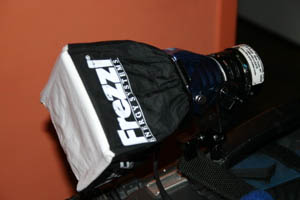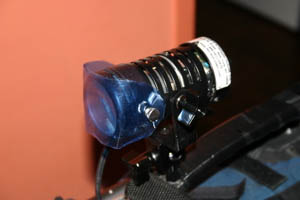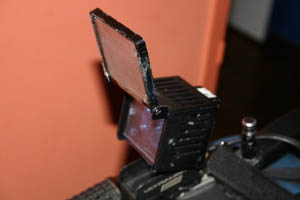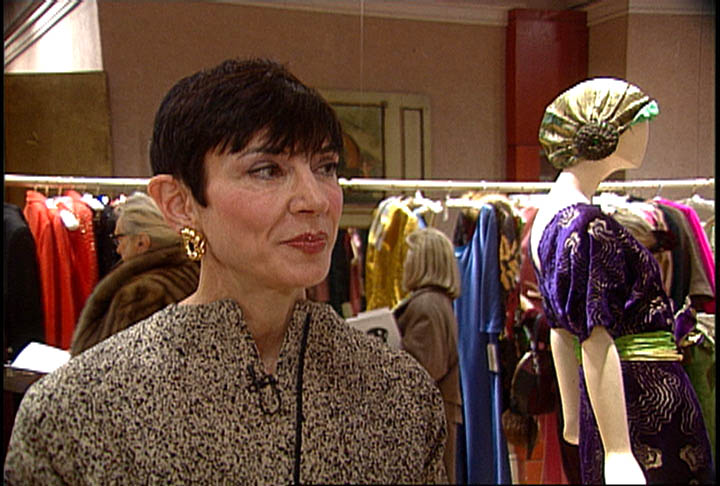
Sun Guns Don't Have To Be Ugly (Part 1)
by Walter Graff

I was playing with a flashlight the other day with my 9 month old son. I handed him the torch only to have him shine it directly into his own eyes. It reminded me of how in this business, it's not the tools one uses but the knowledge of how to use them. A website I frequent had a post about using sun guns, a portion of one response said it best: "We can always tell when ENG footage comes from a certain station in our market: day or night, inside or out, everything is lit with a bare-bulb 1K sungun on top of the camera." He said it all. Just like my son has no idea how to finesse a light, many folks don't either. But it doesn't mean one can not learn. I've been making video for some time so I know the nuances of light. What I am saying is don't expect miracles over night. But one simple rule applies; look at what your shooting and if you see something wrong, it is. I would like to know why sometimes when I watch a sun gun in action, it looks like the sun is going super nova. Does the camera operator see this? Perhaps he's not looking at what he is shooting? Does he have zebras in his camera that ell him he is over exposing a face? Or perhaps he is like my son and just never had anyone tell him what to look for? Over the years I’ve used every imaginable “sun gun” made, from the original GE “sun gun” in the 80’s which looked something like a headlight out of the 30’s but made a lot of light, to an LED version I built myself. And in the end, regardless of what you are using, the secret to using it well is about not making it look like a headlight in someone’s face. So very simply what one has to remember is that regardless of what is in the shot, exposure needs to be based on faces. If your talent is over exposed it's a problem. Iris down. This may make the background a bit darker but then again folks are not going to say, oh the background looks dark. But if they see a face over exposed they are going to notice. Faces are always the most important element in any shot and need to be properly exposed. Currently I use a Frezzolini 50 watt MR16 on-camera light for most of what I do. Actually, I carry that and a Anton Bauer light in my kit and use both depending on my need. The Bauer has a 20 watt lamp in is more like a beam of light but less intense, while the frezzi a bit wider so they have their uses depending on the application. The situation I sometimes use these lights is for supplementation when the room is well lit with fluorescent fixtures from the ceiling. The Anton Bauer light and Frezzi light fills in the shadows nicely. In addition I have a flip down door on the Anton Bauer that I attached a piece of 216 diffusion to the help take the edge off the light even more. I tend to use a sun gun less as a direct light and often as a bounce. Of course if I’m doing man-on-the-street at night, its tougher to soften it all up, but not impossible. Sometimes I take along a piece of white foam core and rather than turn the light forward, aim it backwards and place the foam core on the camera with a clip. It makes a nice bounce light. I recently began shooting a second season of a series for the Fine Living Channel. It’s called “Auction Adventure”. I am often faced with the task of lighting my talent while he is on the floor of an auction house or in some place where plugging a light in is not always easy to do or possible. Set-ups needed to be quick, and there is no effective place to plug in a light so my sun gun becomes my prime fixture for lighting. Sometimes using it bare, sometimes with tech small Chimera attached and sometimes bouncing it off a white card mounted on the camera. In tech end as long as my faces are exposing properly, I use what method gives me the best results. In the photos that follow I show you what I use and an example of how I use it in a situation where most folks would not. |

My favorite light and accessory. This is a Frezzolini 50 watt fixture With this soft box, I can fill in my talent without making it look like the 4:21 train is pulling into the station. |

While the companies that make these lights offer all sorts of accessories, I find noting better than my own piece of CTB for shots where I have to balance color temperature better. In this shot I have two pieces of half CTB ganged up and trimmed to fit the front of the fixture. If I need a warmer look in the 4000k range I simply slip one sheet of the CTB up and out of the way. If I need 3000k I slide them both up. I cut holes in the gels initially and fastened them with the existing screws on the side of the fixture for a more permanent filter. |

Here is my Anton Bauer 20 watt light. The flip up door is their diffuser but I never thought it diffused enough so I taped 216 inside it to help diffuse more. It’s a good light when you need a little but don’t want to overpower someone. Here’s an answer to a question I am often asked, “What light can I use that will work well PLUGGED INTO my DVX100 or similar camera?” My answer is none. I’d rather see someone with something like a Bescor light and battery attached to his or her belt than one of those DV camera lights that suck power from your camera battery and use MR20 lamps which are smaller and even less appealing than MR16s. Why take chances on not having enough juice? Regardless of what light you use, make sure its soft, and then don’t stand 2 feet from someone. Rather stand back a bit till the light becomes a softer fill. Or add 216 diffusion to the front of it and soften the light. The key is exposure. Putting a bright light on a camera and not compensating for facial exposure is a disaster waiting to happen. A sun gun can look nice if you learn to look at what it’s doing with your eye, not necessarily through the viewfinder. That’s another secret to using one well. Learn to shoot with both eyes. Watch pros. Seasoned pros have both eyes open and know how to switch focus from one eye to the other. You should use the free eye for reality reference and your viewfinder eye for confidence and exposure. Together you’ll learn to make much nicer pictures. |

The results of using a sun gun: A sun gun doesn’t have to look like a sun gun. Here is a frame of video where we are interviewing a woman. Notice that while the background has hot elements from natural lighting, the women’s face is evenly lit. Between the light that spills from the natural ceiling fixtures and a well-balanced camera light, I got a nice soft effect that is pleasing to the eyes and lights her softly and evenly. Sometimes I simply need to take an extra step back to make the difference between a flashlight and a fill as I did here. I love the soft look that the little soft box on my Frezzi gives me as also demonstrated here. My suggestion is to make sure you have some diffusion options for your light. Because sometimes 216 is too much diffusion and a more transparent frost diffusion might be better. And don’t feel like you have to stand three feet in front of a person. Sometimes four feet makes all the difference in how that light appears. Use your zebras set at 75-80 units as a guide to facial exposure. When you see it start to peak, you know you have to iris down to compensate or step back slightly from your talent. Faces start to get ugly at 80 units of video so I use 75 as a reference. I even have a flexible arm with a piece of foam core that I sometimes clip to the camera and bounce my light into making a little reflector on the camera for certain situations as I briefly described earlier. That is another option I keep handy. Bottom line is that sometimes one solution isn’t always enough. But most importantly, don’t let the light dictate how it looks, rather use the light to dictate how you want it to look. You wouldn’t just turn on a 1k light to light someone, but would do what you had to in order to adjust it properly to make them look pleasing. People forget that a camera light has the same ability, or maybe no one told them. Perhaps because we lock it to the camera that we think that’s all we can do. But you should have as much control over your camera light as you do any other light in your kit. Don't act like my 9 month old! |